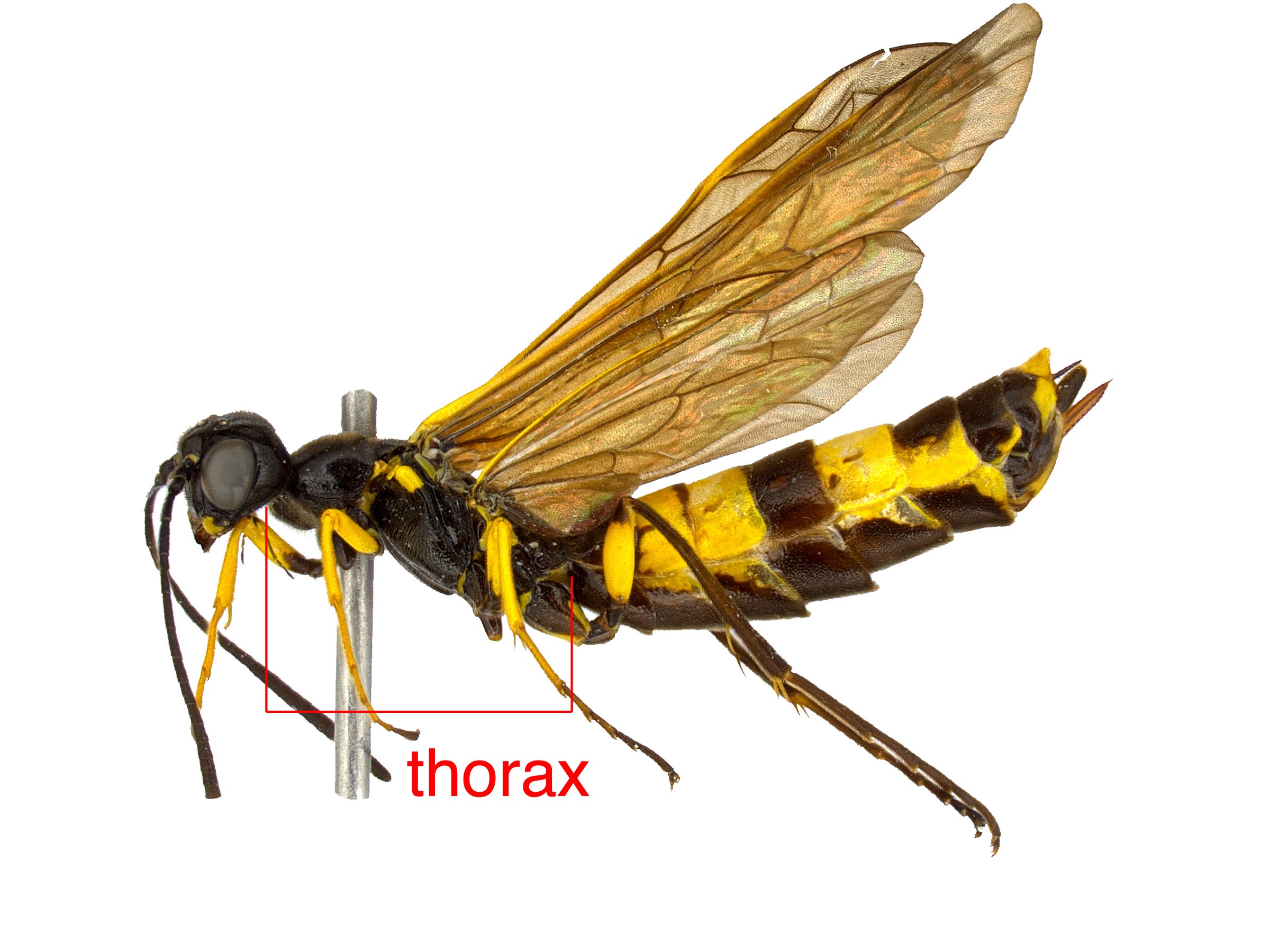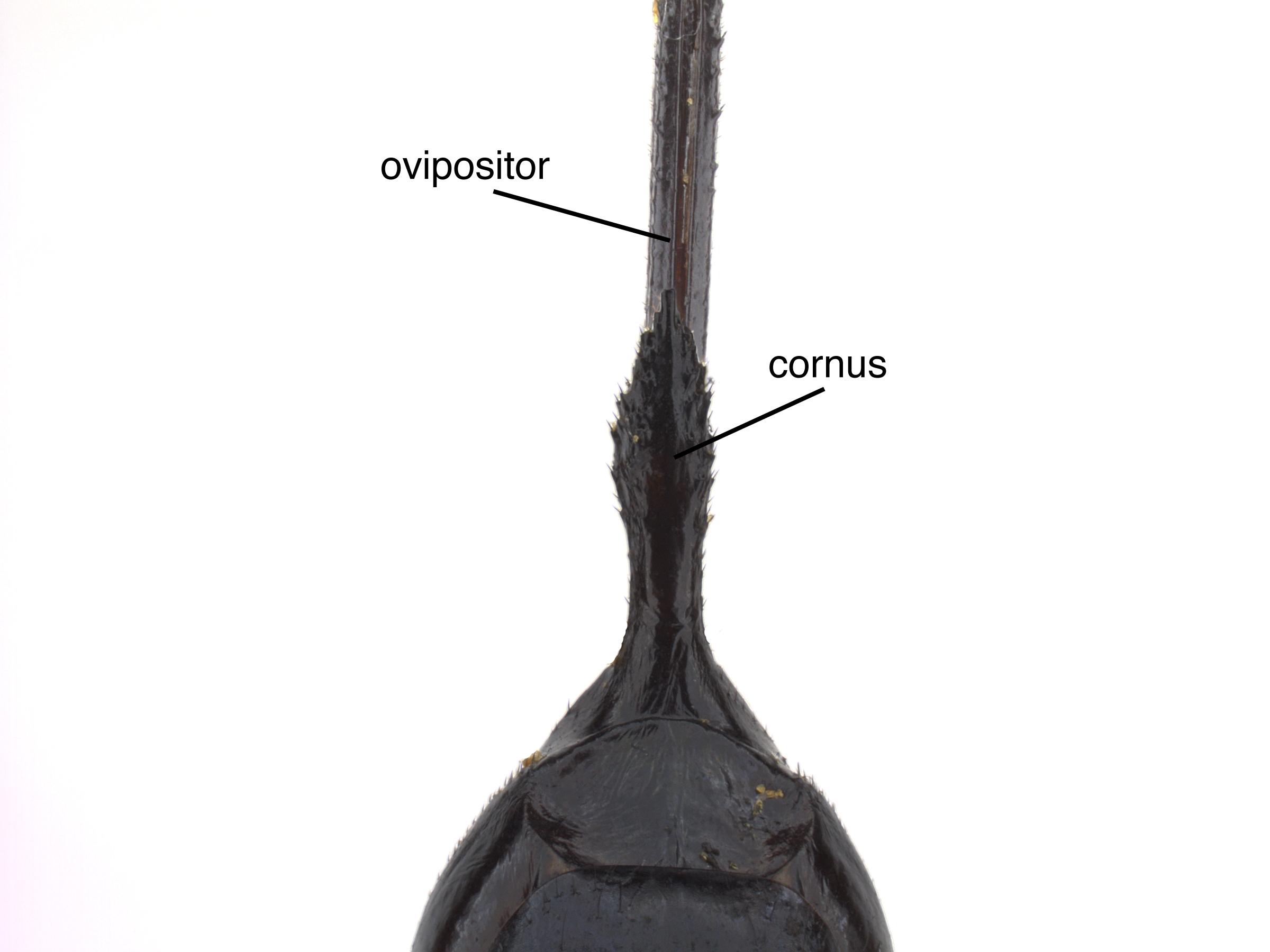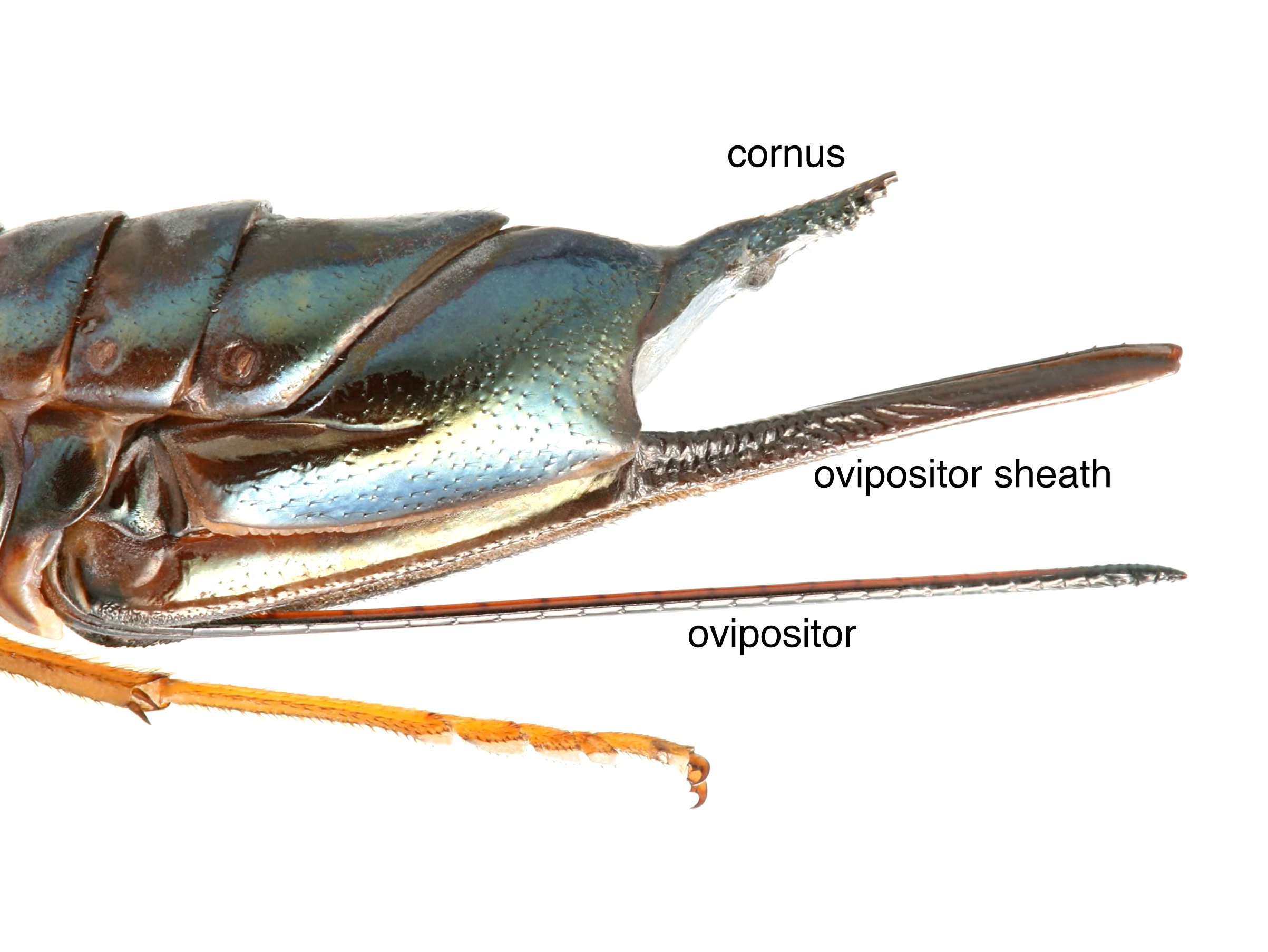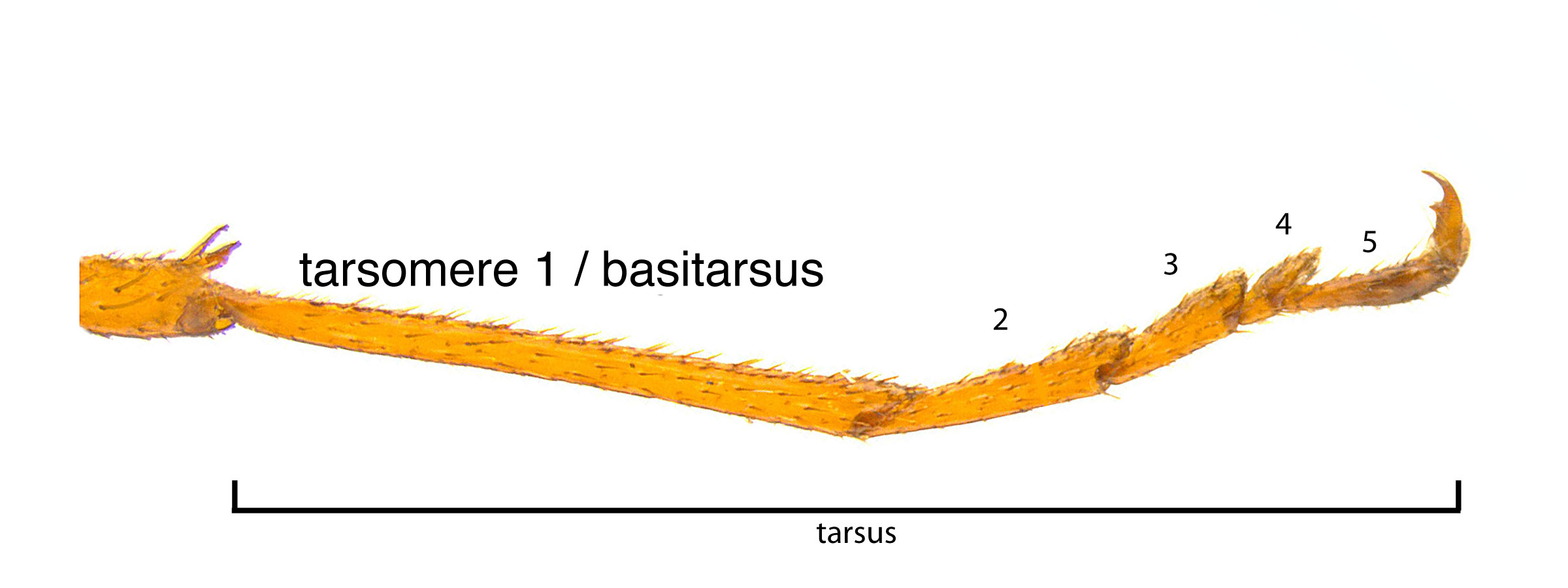Family: Siricidae
Subfamily: Siricinae
Genus: Sirex Linnaeus, 1760
Species: Sirex tianshanicus (Semenov, 1921)
Common names: none
Sirex tianshanicus is a rare species known from central Asia (Smith 1978Smith 1978:
Smith DR. 1978. Suborder Symphyta (Xyelidae, Parachexyelidae, Parapamphiliidae, Xyelydidae, Karatavitidae, Gigasiricidae, Sepulcidae, Pseudosiricidae, Anaxyelidae, Siricidae, Xiphydriidae, Paroryssidae, Xyelotomidae, Blasticotomidae, Pergidae). Hymenopterorum Catalogus 14: 1-193.). The name comes from the Tian Shan mountain range (Kazenas and Temreshev 2016Kazenas and Temreshev 2016:
Kazenas VL and Temreshev II. 2016. Horntails (Hymenoptera: Siricidae, Xiphydriidae) of Almatinskaya Oblast of Kazakhstan. Euroasian Entomological Journal 15 (5): 403-411.).
See Sirex for genus-level diagnostic characteristics.
Females:
 metallic blue-green; abdomenabdomen:
metallic blue-green; abdomenabdomen: metallic blue-purple (Kazenas and Temreshev 2016Kazenas and Temreshev 2016:
metallic blue-purple (Kazenas and Temreshev 2016Kazenas and Temreshev 2016: hyaline (Kazenas and Temreshev 2016Kazenas and Temreshev 2016:
hyaline (Kazenas and Temreshev 2016Kazenas and Temreshev 2016: black (Kazenas and Temreshev 2016Kazenas and Temreshev 2016:
black (Kazenas and Temreshev 2016Kazenas and Temreshev 2016: long (Kazenas and Temreshev 2016Kazenas and Temreshev 2016:
long (Kazenas and Temreshev 2016Kazenas and Temreshev 2016: length about equal to length of abdomenabdomen:
length about equal to length of abdomenabdomen: from basebase:
from basebase: (Kazenas and Temreshev 2016Kazenas and Temreshev 2016:
(Kazenas and Temreshev 2016Kazenas and Temreshev 2016:Males:
 blue with a slight greenish tint (Kazenas and Temreshev 2016Kazenas and Temreshev 2016:
blue with a slight greenish tint (Kazenas and Temreshev 2016Kazenas and Temreshev 2016: hyaline (Kazenas and Temreshev 2016Kazenas and Temreshev 2016:
hyaline (Kazenas and Temreshev 2016Kazenas and Temreshev 2016: black (Kazenas and Temreshev 2016Kazenas and Temreshev 2016:
black (Kazenas and Temreshev 2016Kazenas and Temreshev 2016: and tarsustarsus:
and tarsustarsus: red; mid tibiatibia:
red; mid tibiatibia: black with a reddish spot; hind tibiatibia:
black with a reddish spot; hind tibiatibia: and most of tarsustarsus:
and most of tarsustarsus: black (Kazenas and Temreshev 2016Kazenas and Temreshev 2016:
black (Kazenas and Temreshev 2016Kazenas and Temreshev 2016: 5 red (Kazenas and Temreshev 2016Kazenas and Temreshev 2016:
5 red (Kazenas and Temreshev 2016Kazenas and Temreshev 2016:Sirex tianshanicus females are similar to S. juvencus and can be distinguished by a slightly longer ovipositorovipositor:
the female organ that deposits eggs and is used to drill into plant tissue, located at the apex of the abdomen, made up of the lance and lancet
 (about 0.75 times length of fore wingfore wing:
(about 0.75 times length of fore wingfore wing:
the anterior wing of each pair of wings; usually the largest wing of the pair
 ) and the green coloration (Benson 1943Benson 1943:
) and the green coloration (Benson 1943Benson 1943:
Benson RB. 1943. Studies in Siricidae, especially of Europe and southern Asia (Hymenoptera, Smphyta). Bulletin of Entomological Research 34 (1): 27-51. https://doi.org/10.1017/S0007485300023464, Kazenas and Temreshev 2016Kazenas and Temreshev 2016:
Kazenas VL and Temreshev II. 2016. Horntails (Hymenoptera: Siricidae, Xiphydriidae) of Almatinskaya Oblast of Kazakhstan. Euroasian Entomological Journal 15 (5): 403-411.).
none recorded
Sirex species feed on trees of Pinaceae and Cupressaceae. Sirex tianshanicus is known from Picea schrenkiana (Asian spruce) (Smith 1978Smith 1978:
Smith DR. 1978. Suborder Symphyta (Xyelidae, Parachexyelidae, Parapamphiliidae, Xyelydidae, Karatavitidae, Gigasiricidae, Sepulcidae, Pseudosiricidae, Anaxyelidae, Siricidae, Xiphydriidae, Paroryssidae, Xyelotomidae, Blasticotomidae, Pergidae). Hymenopterorum Catalogus 14: 1-193.).
Female Sirex harbor symbiotic basidiomycete fungus in abdominal glands called mycangia. During oviposition, the site is inoculated with the fungus (Amylostereum spp.), which begins to decompose the surrounding wood. LarvaeLarva:
the immature stage of holometabolous insects
 feed on the fungus, and in the process bore galleries through the wood (Schiff et al. 2012Schiff et al. 2012:
feed on the fungus, and in the process bore galleries through the wood (Schiff et al. 2012Schiff et al. 2012:
Schiff NM, Goulet H, Smith DR, Boudreault C, Wilson AD, and Scheffler BE. 2012. Siricidae (Hymenoptera: Symphyta: Siricoidea) of the Western Hemisphere. Canadian Journal of Arthropod Identification 21: 1-305.).
Larvae are creamy white and grub-like in appearance with a dark head capsule. As with adults, larvaelarva:
the immature stage of holometabolous insects
 possess a short dorsaldorsal:
possess a short dorsaldorsal:
of or on the top surface of the body or structure
horn on the posterior end of the body. The larvaelarva:
the immature stage of holometabolous insects
 bore galleries into wood, feeding until pupation and subsequent emergence. Throughout this process, the larvaelarva:
bore galleries into wood, feeding until pupation and subsequent emergence. Throughout this process, the larvaelarva:
the immature stage of holometabolous insects
 use their horn to pack the tunnel behind them with sawdust. Emergence holes are perfectly circular. The fungal symbiont is carried in specialized organs in female larvaelarva:
use their horn to pack the tunnel behind them with sawdust. Emergence holes are perfectly circular. The fungal symbiont is carried in specialized organs in female larvaelarva:
the immature stage of holometabolous insects
 that develop into the mycangia after metamorphosis (Schiff et al. 2012Schiff et al. 2012:
that develop into the mycangia after metamorphosis (Schiff et al. 2012Schiff et al. 2012:
Schiff NM, Goulet H, Smith DR, Boudreault C, Wilson AD, and Scheffler BE. 2012. Siricidae (Hymenoptera: Symphyta: Siricoidea) of the Western Hemisphere. Canadian Journal of Arthropod Identification 21: 1-305.).
This species generally oviposits into dying or damaged trees. The damage inflicted by S. tianshanicus in the forests of the Tien Shan mountain range is minor on its own, but in conjunction with human-inflicted tree damage and other pest pressure, can lead to the death of the tree (Kazenas and Temreshev 2016Kazenas and Temreshev 2016:
Kazenas VL and Temreshev II. 2016. Horntails (Hymenoptera: Siricidae, Xiphydriidae) of Almatinskaya Oblast of Kazakhstan. Euroasian Entomological Journal 15 (5): 403-411.).
The flight period of S. tianshanicus is June through September (Kazenas and Temreshev 2016Kazenas and Temreshev 2016:
Kazenas VL and Temreshev II. 2016. Horntails (Hymenoptera: Siricidae, Xiphydriidae) of Almatinskaya Oblast of Kazakhstan. Euroasian Entomological Journal 15 (5): 403-411.).
World: Sirex tianshanicus is recorded in the Tian Shan mountainous regions of western China, Kyrgyzstan, and Kazakhstan (Smith 1978Smith 1978:
Smith DR. 1978. Suborder Symphyta (Xyelidae, Parachexyelidae, Parapamphiliidae, Xyelydidae, Karatavitidae, Gigasiricidae, Sepulcidae, Pseudosiricidae, Anaxyelidae, Siricidae, Xiphydriidae, Paroryssidae, Xyelotomidae, Blasticotomidae, Pergidae). Hymenopterorum Catalogus 14: 1-193., Kazenas and Temreshev 2016Kazenas and Temreshev 2016:
Kazenas VL and Temreshev II. 2016. Horntails (Hymenoptera: Siricidae, Xiphydriidae) of Almatinskaya Oblast of Kazakhstan. Euroasian Entomological Journal 15 (5): 403-411.).
North America: not recorded
Map data from: GBIF.org (26 June 2019) GBIF Occurrence Download Sirex tianshanicus
Details about data used for maps can be found here.